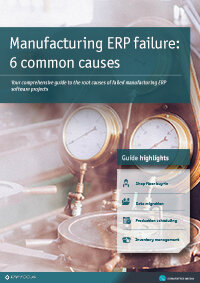Top 10 causes of ERP implementation failure (and how to avoid it)
Few people in an organization ever understand how difficult an ERP implementation is, and how a few key elements can be the difference between ERP success and ERP failure.
ERP implementation failure is a disaster for any organization - an ERP is a costly venture for any business, and losing that amount of time and money implementing a system that doesn't work will be costly. Avoiding ERP failure is paramount - which means planning your selection and implementation well.
Listed below are some of the common mistakes that, if avoided, can greatly improve your probability of success.
The causes of ERP failure include
- Poor software fit /inaccurate requirements
- Business leadership is not committed to the implementation
- Insufficient team resources
- Lack of accountability to make timely, high quality decisions
- Lack of investment in change management
- Insufficient training/support
- Insufficient funding
- Insufficient data cleansing
- Insistence on making ERP look like legacy
- Lack of testing
1. Poor software fit /inaccurate requirements
Your requirements are the single most important component of a successful ERP implementation. Meet with managers and users from every discipline and with senior executives as well. Aggressively pursue any points where they have pain today that can be resolved. Examine future plans and forecasts and anticipate where similar pains might occur. Now pare that list until all concur you have agreement on a comprehensive list of both requirements and features not required but would be valuable.
Have a highly detailed and accurate inventory of system requirements in hand before you begin shopping for an ERP system. Be relentless with questions; ERP vendors will be overly optimistic about their product’s fit to your problems. Never choose bells and whistles over nuts and bolts. If any potential ERP system cannot meet all your requirements, keep looking, there is a system that will satisfy your requirements.
GET ERP RESEARCH & KNOWLEDGE RIGHT TO YOUR INBOX
Covering the key issues faced by businesses selecting and implementing ERP.
2. Business leadership is not committed to the implementation
Without this commitment, no one else in the organization will be committed either. Recommend postponement of the ERP project rather than gamble leadership attitudes will somehow “come around”.
Executive management has the power to allocate resources to the ERP project. And they have the power to reallocate them as conditions change. Money is one resource and if they will not pay for ERP, the project is on hold. People are a critical resource too. Valuable people will be needed to work on ERP implementation and their previous jobs still need to be done. Backfilling those roles requires temporary replacements or a recognition that some tasks cannot be completed in the same way they were.
ERP implementation is an enterprise-wide task. It cannot be seen as information services or manufacturing only so executives from all departments must commit to the use of every needed resource.
3. Insufficient team resources
This can be the number of resources, but it is even more important to get the right resources into your ERP team in terms of talent and experience. Your ERP implementation will fail if the enterprise fails to devote the resources required for success. You can hire additional people from outside as contractors or employees or you can devote some or all of the time available from people already within the business but somehow, significant amounts of time will be necessary.
If you choose to use existing resources, their current “day jobs” still need to be completed and the ERP implementation should be their primary task to complete. Those resources required also can be outside help for specific purposes such as programming unique to data conversion. One resource not to be skipped is a team manager who will coordinate all the efforts and report to executive management and a steering team on the progress of the project.
4. Lack of accountability to make timely, high-quality decisions
Establish early on who is responsible for what level of decision making. Late, ambiguous, or poor quality decisions can doom your project to ERP failure. Most of the decisions to be made throughout your ERP implementation should be made at the team level. Waiting for executive management will needlessly delay the implementation process and the best decision will come from people on the team who are already users of the systems and familiar with the processes and what changes will improve the situation.
5. Lack of investment in change management
No matter what the business case says, the rank and file will not be looking forward to ERP. The only intelligent course is to over-communicate and over-prepare. Your good communication will keep the reasons for the ERP implementation and the expected improvements in everyone’s attention. Assuming that people will accept your plans and offer their support can quickly lead to an ERP implementation failure.
Change is a psychological factor. Some quickly will see the future possibilities. Some others cannot imagine different processes that will be better than those already familiar and mostly satisfactory. Consider employing change management specialists as part of your implementation team. Those specialists will recognize different personalities and know how to work with all to help your staff accept and embrace the future.
Guide: ERP Implementation - 11 steps to success
6. Insufficient training /support
An ERP implementation requires trained users. Any users not trained in advance will be siphoning off resources from the implementation support team. As the available support resources diminish, the ability to resolve go-live problems decreases, and the implementation implodes.
7. Insufficient funding
ERP implementations are expensive, and you should always be conscientious about not wasting money. However, the cost of an ERP failure makes the implementation cost seem like pocket change. Make your best estimate of cost and increase that estimate by 25% when you ask for a budget.
The cost of the new ERP software is only the beginning factor. As the implementation moves along, you will have incremental payroll costs and you will need to pay for contractors and specialists in various disciplines. Likely there will be costs to improve your hardware, networks, and other infrastructures to ensure the new ERP works as needed.
Your ERP developer will continue making improvements in the system and working to fix bugs and other problems found over time. There will be ongoing support and maintenance costs with ERP as you should expect from any significant enterprise system. Yes, you should expect savings over time but much of the cost will come ahead of the savings and those costs must be funded or the implementation can fail.
8. Insufficient data cleansing
Data cleansing and preparation is an enormous Catch-22 and requires patience and persistence. The Catch-22 is that the correct format and choices for data cannot occur without understanding how the system works, but the system won’t work without correctly formatted data. The system build and data cleansing must occur in tandem. This can easily be the cause of your failed ERP implementation.
Begin by separating your data into two classes, static and dynamic. Static data are elements like addresses of suppliers that only need to be entered one time. Dynamic data are transactions.
Find all the static data required in your new ERP, data will reside in tables made up of data fields. Some of those fields will be mandatory but others will be optional depending on the unique needs for your business. Now map the fields you will use back to your legacy systems and determine how to copy data from several legacy sources into records in your new ERP.
Dynamic data transfers are similar but with one significant difference. Your legacy systems probably have years or decades of data. Decide now how much needs to move to the new system. Most of the time only the most current records are needed. There is no benefit to loading your new ERP with data that provides no value. Keep your legacy systems alive on a read-only basis if there is a need to look at historical data in the future.
Examine all the data carefully before loading it into the new ERP. There are always misspellings and other problems you have lived with that can now be cleaned up.
9. Insistence on making ERP look like legacy
Over-customization increases every other cost and risk, it makes upgrading and testing more difficult, and it reduces ERP functionality. While all your users are comfortable with the layout of your legacy systems, some alternatives are as good or even better. The developers of your new ERP put effort into using the best practices and your users will adapt quickly. The goals are to meet your chosen requirements, not cosmetics. Customization costs money and should only be needed when there is no other solution and most ERP systems include easy configuration tools that minimize much of the need for customization.
10. Lack of testing
Without serious and repeated testing, building from a single test of every business-critical process and progressing through volume tests and a mock go-live requiring practice at synching up the old systems to the new, the shock and surprise of problem volume at ERP go-live will collapse the implementation effort.
Testing will also reveal data migration problems. A test can fail only because some data element is in an incorrect format, for example. Data migration is also a part of testing. You will migrate data over several iterations as you solve problems found in testing and then reset for additional testing. Document the flow of migrations to find a process that minimizes time and loads all the needed data. At go-live, you will be ready for the fastest and most effective data migration that gets your company back in business quickly.
Much testing can now be accomplished with automated robotics today. This kind of test will run many more times than any number of people can test and because of the large sample size, more potential problems can be found and fixed preventing some implementation failures.
There are other pitfalls, obviously, but if you can do a good job of avoiding these ten, your odds of avoiding an ERP failure will improve dramatically.
Free white paper

ERP Implementation: 9 steps to success
The 9 proven steps you should follow when implementing ERP

Featured white papers
-

Manufacturing ERP Failure: 6 Common Causes
Get your comprehensive guide to the causes of manufacturing ERP failure
Download
Related articles
-

9 hidden ERP costs that can blow your implementation budget
Discover critical cost areas of your ERP project that can wreck your budget
-

CMMC Compliance: What Aerospace and Defense Manufacturers Need to Know
Key insights on CMMC compliance, deadlines, and securing DoD contracts with CMMC 2.0 certificatio...
-

ERP failure: the human factor
How people impact your risk of ERP failure, and how to avoid it

